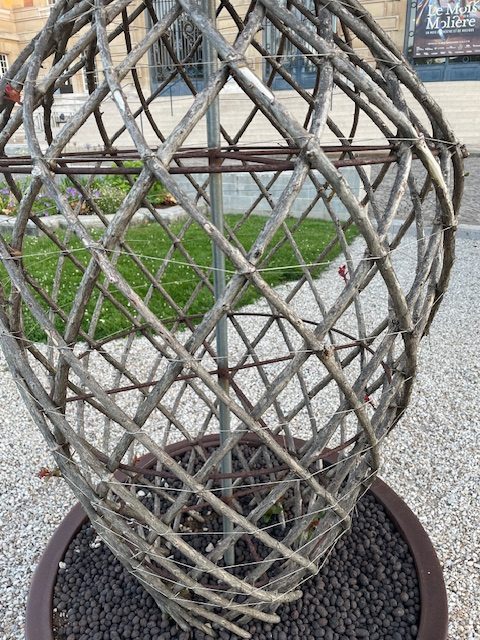By JoAnne Skelly — My friend Roni sent me photos of an unusual plant she saw in Europe last month. Initially, it appeared to be an arrangement of leafy branches in a tall woven vase on top of a ceramic container.
What was actually going on was that the stems of the plant had been woven to look like a vase. The plant was growing in the vase shape. What an amazing accomplishment! And as Roni said “So creative! And what patience to create such a thing!”
 JoAnne Skelly
JoAnne Skelly
Anyone who has ever been to Disneyland has seen plants shaped into animals. There are commercials on TV where a man is shaping a big dinosaur out of plants. We see spiral evergreens sold in nurseries.
Topiary is the art of “the clipping of woody plants (trees and shrubs) into shapes” according to The Huntington Botanical Gardens (www.huntington.org/topiary). Consistent, persistent pruning and shaping are what makes topiary work. Some topiaries are simple; others may be geometric in shapes such as cubes or pyramids. Then of course there are the animals and human shapes.

They may even be pruned into letters. The shapes must be clearly defined in forms that plants don’t grow into in nature. A big part of topiaries is the long-term maintenance, because they are living sculptures always trying to grow out of the determined shape.
Plants have been clipped into shapes since the earliest Roman and Asian times. Topiary was widely practiced during the Renaissance. And of course, English gardens through the centuries made topiaries very popular. Walt Disney took the style into his Disneyland Park in 1962 using Mickey, Goofy and others as models.
Well-pruned hedges could be considered basic topiaries. Forming a topiary starts like pruning a hedge, but there is extensive planning in advance to determine and then define and maintain the shape. In modern topiaries, frames or shaped wire cages may be used onto which the plant material is trained and pruned.
Topiary is not a quick process and as Roni said, it takes patience. To see what someone did creating that vase out of living material impresses me. I wouldn’t call the general pruning of plants done by landscape maintenance people in most yards today topiary. That type of pruning is ‘get it over with quickly and get on to the next job.’
Visit www.huntington.org/topiary or www.longwoodgardens.org to see fun examples of topiary plants. Or simply search online under “topiary gardens” to find out more.
— JoAnne Skelly is an Associate Professor and Extension Educator, Emerita, University of Nevada Cooperative Extension. She can be reached at skellyj@unr.edu.
Like this:
Like Loading…
Related


Comments are closed.